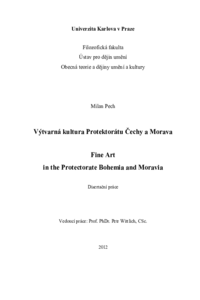Výtvarná kultura Protektorátu Čechy a Morava
Fine Art in the Protectorate Bohemia and Moravia
dizertační práce (OBHÁJENO)

Zobrazit/
Trvalý odkaz
http://hdl.handle.net/20.500.11956/45212Identifikátory
SIS: 25798
Katalog UK: 990015071480106986
Kolekce
- Kvalifikační práce [24991]
Autor
Vedoucí práce
Oponent práce
Lahoda, Vojtěch
Rousová, Hana
Fakulta / součást
Filozofická fakulta
Obor
Dějiny výtvarného umění
Katedra / ústav / klinika
Ústav pro dějiny umění
Datum obhajoby
17. 9. 2012
Nakladatel
Univerzita Karlova, Filozofická fakultaJazyk
Čeština
Známka
Prospěl/a
Klíčová slova (česky)
Výtvarné umění. Protektorát Čechy a Morava. Německá okupace. Nacistická kulturní politika. Entartete Kunst, Zvrhlé umění. Antimodernismus. Cenzura. Konjunktura. Kýč. Historismus. Psychoanalýza. Spolek výtvarných umělců Mánes. Topičův salonKlíčová slova (anglicky)
Fine Arts. Protectorate of Bohemia and Moravia. Occupation. Nazi cultural policy. Entartete Kunst, degenerate art. Antimodernisms. Censorship. Kitsch. Historicism. Psychoanalysis. Mánes Association of Fine Artists. Topič SalonDisertační práce se zabývá výtvarnou kulturou v Protektorátu Čechy a Morava. Analyzuje české výtvarné umění v době nacistické okupace za druhé světové války. Soustředí se přitom na jeho oficiální polohu, která dosud nebyla badatelsky zpracována. Autor vycházel z průzkumu archivních pramenů, dobového tisku a literatury. Cílem práce bylo sledovat nejen klíčová témata veřejné diskuze o uměleckých otázkách, ale také praktický chod českého legálního výtvarného umění v podmínkách okupace. Nejprve přibližuje historický kontext let 1938 až 1945. Spolu s tím reflektuje vybrané patologické jevy, které okupace a válka v české společnosti vyvolaly. Ty, které se promítly do výtvarného umění interpretuje z psychoanalytického hlediska. Poté se soustředí na oficiální kulturní politiku Protektorátu Čechy a Morava. Sleduje krátkodobé a dlouhodobé cíle nacistické okupační strategie a jejich vliv na chod kulturního života české společnosti. Konstatuje, že cenzura odstraňovala z veřejného života díla židovských umělců, dále práce z nacistického hlediska formálně nebo ideologicky nepřípustná. Následně hovoří o radikálně- konzervativní kritice moderního umění, která vinila avantgardu z merkantilismu, politizace umění, cizorodosti nebo umělecké svévolnosti. Dále se soustředí na otázku tzv. zvrhlého umění (entartete...
The thesis deals with fine arts in the Protectorate of Bohemia and Moravia. It analyzes Czech fine art during the Nazi occupation of World War Two, concentrating on its official component that has not yet been deeply researched. The author surveyed archives, press and literature of the period. The aim was to identify key themes in the public discussion about artistic issues and to trace developments in the legal status of Czech fine art under the occupation. First, a brief portrait of the historical context of 1938 to 1945, accompanied by identifying several pathological phenomena that occupation and the war brought to Czech society. Those that crept into the fine arts are interpreted from a psychoanalytic point of view. Next the author focuses on the official cultural policy of the Protectorate of Bohemia and Moravia. He notes the short and long-term objectives of Nazi policies and their impact on the workings of cultural life in Czech society. He speaks about radical conservative critiques of modern art, which accused the avant-garde of mercantilism, of politicizing art, of being foreign, and arbitrary. So-called "degenerate" art (Entartete Kunst) is also briefly mentioned. A term that was used to defame and denounce modern art. For the first time, an unknown list of Czech "degenerate" painters...
